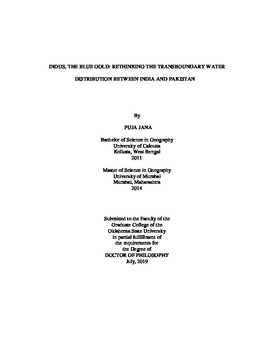| dc.contributor.advisor | Lightfoot, Dale | |
| dc.contributor.author | Jana, Puja | |
| dc.date.accessioned | 2020-01-30T15:03:06Z | |
| dc.date.available | 2020-01-30T15:03:06Z | |
| dc.date.issued | 2019-07 | |
| dc.identifier.uri | https://hdl.handle.net/11244/323349 | |
| dc.description.abstract | The Indus River and its five tributaries rising in the Himalayan Mountains in India flows through Pakistan and ultimately drains into the Arabian Sea. The water resource of these rivers aids in the generation of hydroelectricity, navigation and sustains the agriculture of India and Pakistan. Since the partition of India and Pakistan in 1947, there have been repeated conflicts regarding these transboundary rivers between the two nuclear powered nations due to faulty boundary planning and due to Chinese interference in the upstream Indus. Previous scholarship mostly focuses on the political debates of water sharing; few studies have focused on the effect of the water dispute on the agriculture of the countries. I will use GIS technology to map the changing patterns in agricultural activity and draw an analogy between the river's flow volume and speed with the temporal and spatial pattern of agricultural activity and power generation in the two riparian countries. Qualitative analysis involving personal interviews of the farmers cultivating in the Indus Basin and key informant interviews helped in understanding changing perceptions and real-life experience. Analysis of the research data shows disturbing displacement of village people due to dam constructions and misuse of the river water. This research will help in forming a deeper understanding of the water sharing issues persisting in one of the largest river systems and the largest irrigation canal system in the world. The unique methodology used will help in understanding the water problem from the common man's perspective and aid in policy formulation. | |
| dc.format | application/pdf | |
| dc.language | en_US | |
| dc.rights | Copyright is held by the author who has granted the Oklahoma State University Library the non-exclusive right to share this material in its institutional repository. Contact Digital Library Services at lib-dls@okstate.edu or 405-744-9161 for the permission policy on the use, reproduction or distribution of this material. | |
| dc.title | Indus, the Blue Gold: Rethinking the Transboundary Water Distribution Between India and Pakistan | |
| dc.contributor.committeeMember | Comer, Jonathan | |
| dc.contributor.committeeMember | John, Ranjeet | |
| dc.contributor.committeeMember | Rudloff, Peter | |
| osu.filename | Jana_okstate_0664D_16457.pdf | |
| osu.accesstype | Open Access | |
| dc.type.genre | Dissertation | |
| dc.type.material | Text | |
| dc.subject.keywords | india | |
| dc.subject.keywords | indus | |
| dc.subject.keywords | kashmir | |
| dc.subject.keywords | pakistan | |
| dc.subject.keywords | treaty | |
| dc.subject.keywords | water | |
| dc.subject.keywords | water politics | |
| dc.subject.keywords | gis | |
| thesis.degree.discipline | Geography | |
| thesis.degree.grantor | Oklahoma State University | |
